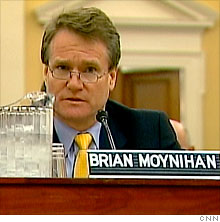If you’re looking for a great primer on the latest developments in the legal saga over who will ultimately bear the losses for the detritus that passed as subprime and Alt-A mortgage loans from 2004 to 2007, check out this article published by Jonathan Laing at Barron’s over the weekend. In the article, entitled “Banks Face Another Mortgage Crisis,” Laing does a great job of bringing the casual observer up to speed on the various efforts by investors and insurers to force originating and securitizing banks to buy back souring mortgage loans that are found to breach the guarantees made when the loans were first originated and sold.
 Among the highlights: the article frankly admits that with $2 trillion in subprime, Alt-A and adjustable rate mortgages having been originated during the last years of the housing boom, the losses on these loans could reach approximately $700 billion. Laing also accurately assesses that the biggest battles the banks will face will come from investors in private label (i.e. non-agency backed) securities, and that banks may seek another government bailout to help ease the significant pain these private label putbacks may cause. Laing also does not mince words about whether the banks deserve to be on the hook for these mortgages. My favorite passage:
Among the highlights: the article frankly admits that with $2 trillion in subprime, Alt-A and adjustable rate mortgages having been originated during the last years of the housing boom, the losses on these loans could reach approximately $700 billion. Laing also accurately assesses that the biggest battles the banks will face will come from investors in private label (i.e. non-agency backed) securities, and that banks may seek another government bailout to help ease the significant pain these private label putbacks may cause. Laing also does not mince words about whether the banks deserve to be on the hook for these mortgages. My favorite passage:
Certainly, some of the major banks amply deserve to suffer additional putback losses. By almost any measure, they were either negligent or willfully culpable in issuing securities with such glaring defects on the global investment markets. They had little incentive to worry much about investment quality, since the securitized loans passed off their balance sheets, ladling all the credit risks onto the credulous buyers.
The banks had created such a fee-rich securities sausage factory during the middle of the current decade that the ingredients going into their products were of little concern. It was merely important to keep production levels elevated even after the pool of creditworthy mortgage borrowers had run dry, only to be replaced by dead-beat subprime borrowers and alt-A mortgage-financed home speculators ready to mail their home keys to their lenders at the first whiff of home-price weakness.
Bankers argue that economic woes rather than shoddy loan underwriting are to blame for most of the lamentable financial performance of the mortgage market. Therefore, the pugnacious CEO of Bank of America, Brian Moynihan, has promised that the bank will engage in “hand-to-hand” combat to fight putback claims. “People who come back and say, ‘I bought a Chevy Vega, but I wanted it to be a Mercedes with a 12-cylinder [engine].’ We’re not putting up with that,” he insisted during a recent conference call.
Yet there’s plenty of evidence that the banks during that key three-year period in the middle of the decade passed off some Yugos as sleek sedans.
Laing also does a great job of pulling some of the juiciest pieces of evidence into his article that suggest that the banks were more than just sloppy–they may have knowingly duped investors regarding the quality of the loans they were selling. Particularly damning is the testimony provided by the former president of Clayton Holdings, D. Keith Johnson, regarding the due diligence firm’s findings and the fact that they were often ignored by the securitizing banks, who “waived” deficient loans into securitizations.
But, I must disagree with a few of the points made in this article. First, Laird refers to the legal principles under which investors will likely proceed to remedy defective mortgages–i.e., the representations and warranties found in the trust agreements–as “arcane.” This wording implies that the legal principles are esoteric or overly complicated, and that investors’ reliance on them to putback loans seeks to take advantage of an obscure technicality. Quite to the contrary, though Pooling and Servicing Agreements (PSAs) were often overly complicated, the reps and warranties provided by lenders were the key contractual guarantees that investors received when agreeing to purchase securities backed by the loans at issue. These guarantees provided investors with the comfort that, though they lacked the capacity to review every loan to make sure it met certain quality thresholds, they could rely on lenders’ statements regarding the loans, and could rest assured that lenders would take back any loans that didn’t comply. Thus, rather than “arcane” legal principles, reps and warranties are fundamental building blocks of any securitization, and the investors have every right to hold banks to their collective word.
Second, Laing describes the content of these reps and warranties as “at best, vague.” I have to respectfully disagree. The reps and warranties provided by subprime and Alt-A lenders were often extensive, and commonly included a representation that the lender would follow its published underwriting guidelines. And even though these were “non-conforming” loans, and thus had more lenient underwriting standards than those for agency-backed or “conforming” loans, they were still underwritten with concrete guidelines about what characteristics they had to possess and the procedure that had to be followed by the lender when determining whether the borrower qualified for a loan.
A commonly misunderstood aspect of these loans is that many were so-called “stated income loans,” that is, the borrower did not need to provide proof of income, but simply stated it on the loan application. Many take this to mean that the lender had no responsibility to confirm the accuracy of this statement, and instead could take at face value whatever the borrower claimed to make as income. Yet, originators of stated income loans generally included in their published guidelines that they would confirm that the borrower’s stated income was reasonable and in line with the borrower’s occupation and years of experience. Originators had extensive databases they were supposed to use to perform this review function. When going back and reviewing a loan file after the fact, it is relatively easy to determine whether the originator followed this procedural step. If it did not, it’s a clear breach of the underwriter’s guidelines, regardless of whether the borrower’s stated income turned out to be true or false. It has long been my view here at The Subprime Shakeout that once loan files are turned over to investors, it will not be difficult to prove that there were widespread breaches of lenders’ underwriting guidelines and procedures.
Finally, Laing takes it as a given that banks will be on their own this time, i.e., that the federal government will have no appetite to provide the banks with any financial assistance to ease the pain of this latest mortgage crisis. I am not so sure that this can be assumed. Instead, I think regulators are eager to avoid another financial panic like the one that was touched off by the failure of Lehman Brothers. Should one of the Big Four banks become dangerously undercapitalized upon the crystallization of putback liability, I’m afraid that the government will be asked (and be under intense political pressure) to step in once again. I don’t necessary agree with this approach, but given what we’ve seen over the last two years, it certainly can’t be ruled out.
All told, though I take issue with some of the finer points contained within this article, I commend Mr. Laird on this fine piece of journalism and encourage readers looking for a concise and intelligible summary of banks’ potential subprime mortgage liabilities to check it out.
Thanks to Manal Mehta at Branch Hill Capital for first alerting me to this story – IMG.




